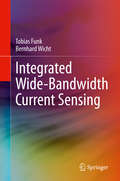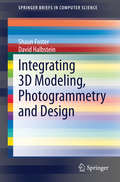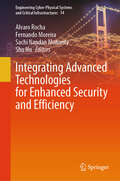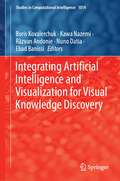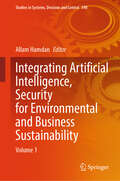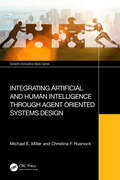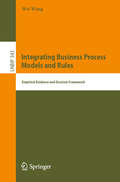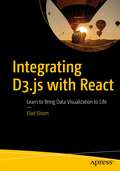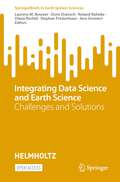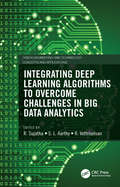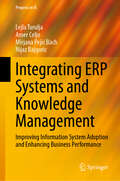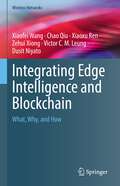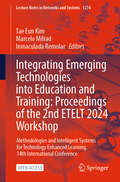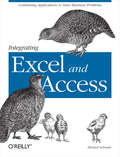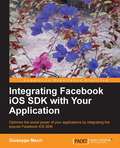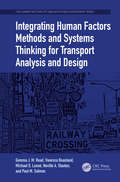- Table View
- List View
Integrated Uncertainty in Knowledge Modelling and Decision Making: 9th International Symposium, IUKM 2022, Ishikawa, Japan, March 18–19, 2022, Proceedings (Lecture Notes in Computer Science #13199)
by Van-Nam Huynh Masahiro Inuiguchi Katsuhiro Honda Tomoe Entani Seiki UbukataThis book constitutes the refereed proceedings of the 98th International Symposium on Integrated Uncertainty in Knowledge Modelling and Decision Making, IUKM 2021, held in Ishikawa, Japan, in March 2022. The 30 full papers presented were carefully reviewed and selected from 46 submissions. The papers deal with all aspects of uncertainty modelling and management and are organized in topical sections on uncertainty management and decision making, optimization and statistical methods, pattern classification and data analysis, machine learning, and economic applications.
Integrated Wide-Bandwidth Current Sensing
by Tobias Funk Bernhard WichtThis book provides readers with a single-source reference to current sensing integrated circuit design. It is written in handbook style, including systematic guidelines and implementation examples. The authors focus on the implementation of wide-bandwidth current sensing on a single microchip, toward usage in applications such as sensing, control and optimization of the energy flow in growth areas like industrial electronics, renewable energies, smart grids, electromobility and the Internet of Things.Provides readers with a comprehensive, all-in-one source for current sensing integrated circuit design, including implementation examples;Discusses modeling and optimization of on-chip Rogowski coil and Hall sensor in both lateral and vertical orientation;Includes noise reduction techniques, such as auto-zeroing and chopping;Covers open-loop and closed-loop sensor front-end design;Presents the first on-chip current sensor with a planar coil placed besides a power line to measure internal signal currents and the first off-chip current sensor with a helix-shaped coil for external signal currents in the multi-MHz region.
Integrating 3D Modeling, Photogrammetry and Design
by Shaun Foster David HalbsteinThis book looks at the convergent nature of technology and its relationship to the field of photogrammetry and 3D design. This is a facet of a broader discussion of the nature of technology itself and the relationship of technology to art, as well as an examination of the educational process. In the field of technology-influenced design-based education it is natural to push for advanced technology, yet within a larger institution the constraints of budget and adherence to tradition must be accepted. These opposing forces create a natural balance; in some cases constraints lead to greater creativity than freedom ever can - but in other cases the opposite is true. This work offers insights into ways to integrate new technologies into the field of design, and from a broader standpoint it also looks ahead, raising further questions and looking to the near future as to what additional technologies might cause further disruptions to 3D design as well as wonderful creative opportunities.
Integrating AI Techniques into the Design and Development of Smart Cyber-Physical Systems: Defense, Biomedical, Infrastructure, and Transportation (Prospects in Smart Technologies)
by D. Jeya Mala Anto Cordelia Dhanapal Saurav Sthapit Anita KhadkaBuilding on the knowledge of risks, vulnerabilities, and safety measures associated with cyber-physical systems, this book focuses on adapting artificial intelligence (AI) techniques to smart cyber-physical systems application development. The future is going to see cyber-physical systems in almost every aspect of life, so a book that focuses on shedding light on the design, development, and security aspects of cyber-physical systems in more crucial domains such as defense, healthcare, biomedical, smart city applications, is needed.Integrating AI Techniques into the Design and Development of Smart Cyber-Physical Systems: Defense, Biomedical, Infrastructure, and Transportation offers an introductory exploration of the fundamental theories and concepts of AI and machine learning (ML) that are utilized in the building of dependable cyber-physical systems. It brings the ideas of advanced design and development and empowered security measures to cyber-physical systems. By focusing on the application of AI in cyber-physical systems design as well as security aspects, an improvement in reliability and advancements can be explored. Also included are the latest findings and advancements as well as case studies and illustrative examples on the design and development of smart cyber-physical systems.This resource is highly valuable for those employed in educational institutions, research laboratories, enterprises, and government agencies, as well as for students seeking novel ideas in the realm of smart cyber-physical systems design.
Integrating Advanced Technologies for Enhanced Security and Efficiency (Engineering Cyber-Physical Systems and Critical Infrastructures #14)
by Alvaro Rocha Shu Hu Sachi Nandan Mohanty Fernando MoreiraThis book examines the profound impact of emerging innovations on security and operational effectiveness. This book brings together leading experts in artificial intelligence, blockchain, IoT, and cyber security to tackle key challenges in protecting digital and physical infrastructures. Covering areas such as automated threat detection, secure data exchange, and intelligent system optimization, the book offers practical strategies and case studies. Designed for researchers, professionals, and policymakers, it serves as a comprehensive resource for harnessing advanced technologies to build resilient and efficient security frameworks. Whether mitigating cyber threats, streamlining industrial operations, or improving decision-making, this book provides essential insights for navigating today&’s rapidly evolving technological landscape.
Integrating Artificial Intelligence and Visualization for Visual Knowledge Discovery (Studies in Computational Intelligence #1014)
by Ebad Banissi Kawa Nazemi Boris Kovalerchuk Răzvan Andonie Nuno DatiaThis book is devoted to the emerging field of integrated visual knowledge discovery that combines advances in artificial intelligence/machine learning and visualization/visual analytic. A long-standing challenge of artificial intelligence (AI) and machine learning (ML) is explaining models to humans, especially for live-critical applications like health care. A model explanation is fundamentally human activity, not only an algorithmic one. As current deep learning studies demonstrate, it makes the paradigm based on the visual methods critically important to address this challenge. In general, visual approaches are critical for discovering explainable high-dimensional patterns in all types in high-dimensional data offering "n-D glasses," where preserving high-dimensional data properties and relations in visualizations is a major challenge. The current progress opens a fantastic opportunity in this domain. This book is a collection of 25 extended works of over 70 scholars presented at AI and visual analytics related symposia at the recent International Information Visualization Conferences with the goal of moving this integration to the next level. The sections of this book cover integrated systems, supervised learning, unsupervised learning, optimization, and evaluation of visualizations. The intended audience for this collection includes those developing and using emerging AI/machine learning and visualization methods. Scientists, practitioners, and students can find multiple examples of the current integration of AI/machine learning and visualization for visual knowledge discovery. The book provides a vision of future directions in this domain. New researchers will find here an inspiration to join the profession and to be involved for further development. Instructors in AI/ML and visualization classes can use it as a supplementary source in their undergraduate and graduate classes.
Integrating Artificial Intelligence, Security for Environmental and Business Sustainability: Volume 1 (Studies in Systems, Decision and Control #598)
by Allam HamdanThis book delves into the crucial role of AI in addressing environmental challenges and driving sustainable business operations, while emphasizing the importance of incorporating robust security measures in these endeavors. Integrating Artificial Intelligence, Security for Environmental and Business Sustainability is a comprehensive guide that explores the intersection of artificial intelligence (AI), security, and sustainable practices. Our proposed book provides a solid foundation in AI principles and technologies relevant to environmental and business sustainability. It covers machine learning algorithms, deep learning techniques, and their applications in optimizing resources, managing risks, and enhancing decision-making processes.
Integrating Artificial and Human Intelligence through Agent Oriented Systems Design (Systems Innovation Book Series)
by Michael E. Miller Christina F. RusnockThis book departs from the assumption that Artificial Intelligence (AI) systems will provide a maximum advantage by replacing human cognitive processing. Instead, this book subscribes to the assumption that AI systems will provide a maximal advantage when the system is specifically designed to augment human intelligence. It provides methods for designing effective systems that include one or more humans and one or more AI entities and uses the approach that assumes automation does not replace human activity but fundamentally changes the structure of human work when AI is added to existing systems.Integrating Artificial and Human Intelligence through Agent Oriented Systems Design discusses the potential impact of AI on human work and life and explores why teamwork is necessary today for complex work environments. The book explains the processes and methods humans employ to effectively team with one another and presents the elements of artificial agents that permit them to function as team members in joint human and artificial teams. It discusses design goals and illustrates how the methods that have been used to model the complex interactions among human and artificial agents can be expanded to enable the design of interaction between them to make possible the attainment of the shared goals. Model-Based Systems Engineering (MBSE) tools that provide logical designs of human–agent teams, the AI within these teams, training to be deployed for human and artificial agent team members, and the interfaces between human and artificial agent team members are all covered. MBSE files containing profiles and examples for building MBSE models used in the design approach are featured on the author’s website (https://lodesterresci.com/hat).This book is an ideal read for students, professors, engineers, and project managers associated with designing and developing AI systems or systems that seek to incorporate AI.
Integrating Big Data and IoT for Enhanced Decision-Making Systems in Business: Volume 1 (Studies in Big Data #177)
by Reem Khamis HamdanThis book presents recent research on integrating big data and IoT for enhanced decision-making systems in business. Unlock the future of smart decision-making! This volume dives technology innovation, and human capital growth, empowering leaders, educators, and entrepreneurs to transform businesses, education, and economies for a sustainable digital era.
Integrating Blockchain and Artificial Intelligence for Industry 4.0 Innovations (EAI/Springer Innovations in Communication and Computing)
by Sam Goundar R. AnandanThis book discusses the convergence of artificial intelligence (AI) and Blockchain and how they can work together to help reach the goals of Industry 4.0. The authors first discuss how AI and Blockchain can help increase performance in business. The authors go on to discuss how the technologies can integrate to provide a competitive edge for businesses through improvements in big data, which has allowed firms to organize huge datasets into structured components that computers can process quickly. The authors also cover security implications and how AI and Blockchain can act as a double-edged sword against cyber-attacks. Impacts in programming, calculations, robotization, robots, and equipment are also discussed. This book caters to an extensive cross-sectional and multi-disciplinary readership. Academics, researchers and their students in topics such as artificial intelligence, cyber-physical systems, ethics, robotics, safety engineering, and safety-critical systems should find the book of value.
Integrating Business Process Models and Rules: Empirical Evidence And Decision Framework (Lecture Notes in Business Information Processing #343)
by Wei WangThis book combines multiple research methods, experiment, survey, and design science, as well as traditional measurements and neurophysiological techniques that can capture a variety of cognitive behaviors in human information processing, providing more solid and comprehended research findings. While the focus of the book is the modelling of process models and rules, the methods and techniques used in this book can also be adopted and applied to broader conceptual modelling research incorporating a variety of notations (e.g. UML, ER diagrams) or ontologies.It is a revised version of the PhD dissertation written by the author at the School of Information Technology and Electrical Engineering of the University of Queensland, Australia. In 2018, the PhD dissertation won the "CAiSE PhD Award," granted to outstanding PhD theses in the field of information systems engineering.
Integrating CRM Across Your Organization for Business Success
by Andrew BlackmoreThis book is written for IT leaders across organizations, whether they are managers, project managers, or developers who are charged with integrating CRM into IT systems for business success.
Integrating Computer Science Across the Core: Strategies for K-12 Districts
by Tom Liam Lynch Gerald Ardito Pam AmendolaIntegrating Computer Science Across the Core is a guide to systematizing computer science and computational thinking practices in your school. While most books explain how to teach computer science as a stand-alone discipline, this innovative approach will help you leverage your existing curriculum to deepen and expand students’ learning experiences in all content areas. Effective, equitable, and sustainable, this blueprint provides principals, curriculum directors, directors of technology, and other members of your school or district leadership team with suggested organizational structures, tips for professional learning, and key resources like planning instruments.
Integrating D3.js with React: Learn to Bring Data Visualization to Life
by Elad ElromIntegrate D3.js into a React TypeScript project and create a chart component working in harmony with React. This book will show you how utilize D3 with React to bring life to your charts.Seasoned author Elad Elrom will show you how to create simple charts such as line, bar, donut, scatter, histogram and others, and advanced charts such as a world map and force charts. You'll also learn to share the data across your components and charts using React Recoil state management. Then integrate third-party chart libraries that are built on D3 such as Rechart, Visx, Nivo, React-vi, and Victory and in the end deploy your chart as a server or serverless app on popular platforms. React and D3 are two of the most popular frameworks in their respective areas – learn to bring them together and take your storytelling to the next level. What You'll Learn Set up your project with React, TypeScript and D3.jsCreate simple and advanced D3.js chartsWork with complex charts such as world and force chartsIntegrate D3 data with React state management Improve the performance of your D3 componentsDeploy as a server or serverless app and debug test Who This Book Is ForReaders that already have basic knowledge of React, HTML, CSS and JavaScript.
Integrating Data Science and Earth Science: Challenges and Solutions (SpringerBriefs in Earth System Sciences)
by Laurens M. Bouwer Doris Dransch Roland Ruhnke Diana Rechid Stephan Frickenhaus Jens GreinertThis open access book presents the results of three years collaboration between earth scientists and data scientist, in developing and applying data science methods for scientific discovery. The book will be highly beneficial for other researchers at senior and graduate level, interested in applying visual data exploration, computational approaches and scientifc workflows.
Integrating Deep Learning Algorithms to Overcome Challenges in Big Data Analytics (Green Engineering and Technology)
by R. SujathaData science revolves around two giants: Big Data analytics and Deep Learning. It is becoming challenging to handle and retrieve useful information due to how fast data is expanding. This book presents the technologies and tools to simplify and streamline the formation of Big Data as well as Deep Learning systems. This book discusses how Big Data and Deep Learning hold the potential to significantly increase data understanding and decision-making. It also covers numerous applications in healthcare, education, communication, media, and entertainment. Integrating Deep Learning Algorithms to Overcome Challenges in Big Data Analytics offers innovative platforms for integrating Big Data and Deep Learning and presents issues related to adequate data storage, semantic indexing, data tagging, and fast information retrieval. FEATURES Provides insight into the skill set that leverages one’s strength to act as a good data analyst Discusses how Big Data and Deep Learning hold the potential to significantly increase data understanding and help in decision-making Covers numerous potential applications in healthcare, education, communication, media, and entertainment Offers innovative platforms for integrating Big Data and Deep Learning Presents issues related to adequate data storage, semantic indexing, data tagging, and fast information retrieval from Big Data This book is aimed at industry professionals, academics, research scholars, system modelers, and simulation experts.
Integrating ERP Systems and Knowledge Management: Improving Information System Adoption and Enhancing Business Performance (Progress in IS)
by Lejla Turulja Amer Celjo Mirjana Pejić Bach Nijaz BajgoricThis book combines the Technology Acceptance Model (TAM) and empirical analysis to investigate the adoption of integrated enterprise business information systems (ISs). TAM has been used extensively in the study of ERP acceptance as well as factors in the success or failure of ERP. To date, the adoption of information systems has been studied using various approaches, including Theory of Reasoned Action (TRA) and Theory of Planned Behaviour (TPB), both of which have roots in cognitive psychology (Nicolas et al., 2008). Even though these models have been used in research, the TAM has succeeded in capturing the attention of the information systems community. The book also analyses Knowledge Management Systems (KMSs), illustrating their function as information technologies for storing, improving and distributing intra- and intercompany knowledge. Knowledge management systems are presented as likely the most debated and polemicized topic in the field of knowledge management. Even though these systems are not a crucial aspect of knowledge management, it is evident that all major players in the ERP industry have cloud- and installation-based KMS solutions that they integrate with their ERP modules. After discussing and analysing these topics, the book illustrates how the respective systems can impact business processes and performance. Given its scope, it appeals not only to researchers, but also to practitioners working in these areas of IT.
Integrating ERP, CRM, Supply Chain Management, and Smart Materials
by Dimitris N. ChorafasOrganizations enjoy two kinds of strategic advantages. One is transitory: being in the right place with the right products at the right time. The other comes from having first class management and instituting processes that mobilize an organization, keeping in ahead of the competition. Which would you like to count on for your organization's success?Integrating ERP, CRM, Supply Chain Management, and Smart Materials explores how to create business opportunities and reap savings by: Restructuring and updating of ERP and CRM software as it integrates supply chain management and delivers new killer applications; Evolving opportunities that will develop from the implementation of smart materials, automatic identification, classification systems, and quality assurance projects Auditing the implementation, operation, and maintenance of ERP and CRM software as well as the corrective action taken on the basis of resultsInternet commerce, online supply chain, and advances in technology - all available at increasingly lower costs - make systems of the past obsolete. However, just as new technology creates new opportunities, it can also create unforeseen consequences. By binding a wealth of interdependent issues between the covers of one book, Integrating ERP, CRM, Supply Chain Management, and Smart Materials gives you the tools you need to create proprietary, high value-added solutions.
Integrating Edge Intelligence and Blockchain: What, Why, and How (Wireless Networks)
by Dusit Niyato Xiaofei Wang Victor C. Leung Chao Qiu Xiaoxu Ren Zehui XiongThis book examines whether the integration of edge intelligence (EI) and blockchain (BC) can open up new horizons for providing ubiquitous intelligent services. Accordingly, the authors conduct a summarization of the recent research efforts on the existing works for EI and BC, further painting a comprehensive picture of the limitation of EI and why BC could benefit EI. To examine how to integrate EI and BC, the authors discuss the BC-driven EI and tailoring BC to EI, including an overview, motivations, and integrated frameworks. Finally, some challenges and future directions are explored. The book explores the technologies associated with the integrated system between EI and BC, and further bridges the gap between immature BC and EI-amicable BC.Explores the integration of edge intelligence (EI) and blockchain (BC), including their integrated motivations, frameworks and challenges;Presents how BC-driven EI can realize computing-power management, data administration, and model optimization;Describes how to tailor BC to better support EI, including flexible consensus protocol, effective incentive mechanism, intellectuality smart contract, and scalable BC system tailoring;Presents some key research challenges and future directions for the integrated system.
Integrating Educational Technology Into Teaching
by M. Roblyer Joan HughesA balance of theory, research, and classroom practice helps teachers understand the most effective ways to integrate educational technology Long recognized in the field as the leading educational technology text, Integrating Educational Technology into Teaching links technology integration strategies to specific learning theories, shows pre- and in-service teachers how to plan for technology integration, and offers opportunities to practice integrating technology by designing curriculum to meet teaching and learning needs. Carefully selected exercises, sample lessons, and recommended resources encourage teachers to reflect on their practice as they develop the insights, knowledge, and skills they need to infuse technology across all disciplines. The 8th Edition features updated technology integration and assessment frameworks, helping teachers employ technology in a way that revitalizes students’ interest and engagement in learning. Throughout the book, content is updated to align with the latest ISTE Standards for Educators and Students and showcases the most current tools, methods, and ideas shaping the role of technology in education. Integrating Educational Technology into Teachingis also available via Revel™–an interactive learning environment that enables students to read, practice, and study in one continuous experience.
Integrating Emerging Technologies into Education and Training: Methodologies and Intelligent Systems for Technology Enhanced Learning, 14th International Conference (Lecture Notes in Networks and Systems #1274)
by Marcelo Milrad Tae Eun Kim Inmaculada RemolarThis open access book compiles state-of-the-art research on the development and implementation of advanced learning technologies and AI-assisted tools, showing how they can transform the educational landscape and learning processes in various domains. Covering topics ranging from immersive learning environments to personalized education, it offers insights and practical applications that are shaping the future of classrooms and training programs. This book provides research insights on harnessing emerging technology’s potential to enhance education, and it is an essential reading for educators, researchers, and edu-tech professionals.
Integrating Excel and Access: Combining Applications to Solve Business Problems
by Michael SchmalzIn a corporate setting, the Microsoft Office Suite is an invaluable set of applications. One of Offices' biggest advantages is that its applications can work together to share information, produce reports, and so on. The problem is, there isn't much documentation on their cross-usage. Until now. Introducing Integrating Excel and Access, the unique reference that shows you how to combine the strengths of Microsoft Excel with those of Microsoft Access. In particular, the book explains how the powerful analysis tools of Excel can work in concert with the structured storage and more powerful querying of Access. The results that these two applications can produce together are virtually impossible to achieve with one program separately. But the book isn't just limited to Excel and Access. There's also a chapter on SQL Server, as well as one dedicated to integrating with other Microsoft Office applications. In no time, you'll discover how to:Utilize the built in features of Access and Excel to access dataUse VBA within Access or Excel to access dataBuild connection strings using ADO and DAOAutomate Excel reports including formatting, functions, and page setupWrite complex functions and queries with VBAWrite simple and advanced queries with the Access GUIProduce pivot tables and charts with your data With Integrating Excel and Access, you can crunch and visualize data like never before. It's the ideal guide for anyone who uses Microsoft Office to handle data.
Integrating Facebook iOS SDK with Your Application
by Giuseppe MacrìA tutorial-based guide with chapters focusing on learning and embedding crucial Facebook features.If you are a developer who wishes to develop and monetize your apps on the App store, then this is the book for you. This book assumes you have basic knowledge of iOS programming using Objective-C and XCode, however, prior knowledge of Facebook iOS SDK is not required.
Integrating Human Factors Methods and Systems Thinking for Transport Analysis and Design (The Human Factors, Simulation and Performance Assessment Series)
by Neville A. Stanton Paul M. Salmon Michael G. Lenné Gemma J. Read Vanessa BeanlandGovernments and road safety agencies around the world have either introduced or are considering 'safe system' strategies, a long overdue acknowledgement that different elements of the road system contribute to road safety outcomes. Human factors approaches have a leading role here in both conceptualising the road system as a complex sociotechnical system and in providing practical approaches to support true systems-based countermeasures. This book illustrates the potential for integrating contemporary systems-based human factors methods with modern day driving-assessment methods, such as vehicle instrumentation and driving simulation, to understand and enhance performance in modern day road-transport systems. The book outlines why a fundamental paradigm shift is needed in the way these systems are designed and operated, and illustrates how a wide range of accepted human-factors approaches can be applied successfully to road transport to revolutionise the countermeasure design process. The practical illustrations of these human factors methods are applied to a long-standing road and rail safety issue: rail level crossings, where the road and rail systems intersect. The final chapter of the book highlights the utility of the human factors approach to reducing road trauma and discusses future applications of the approach.
Integrating Human and Artificial Intelligence: Software in the Age of AI
by Stephen K. ReedThis timely book captures recent developments in artificial intelligence (AI) and their far-reaching implications across education, cognition, business, healthcare, and environmental sectors.Drawing from current academic research, government reports, and industry insights, Integrating Human and Artificial Intelligence provides a comprehensive yet accessible overview of the rapid evolution of AI. It helps readers understand in non-technical terms what AI is, what it is capable of achieving, and how to combine the best skills of artificial and human intelligence to develop a human-centered AI. This will be vital to overcome challenges to protect data privacy, promote fairness, minimize bias, and be culturally responsive. The book's broad scope and contemporary focus make it a welcome addition to the field, especially as an educational resource introducing students and practitioners to the practical applications and societal impact of AI.Well-grounded in recent scholarship, this book will be particularly valuable for students and researchers of cognitive psychology, AI, and technology.

